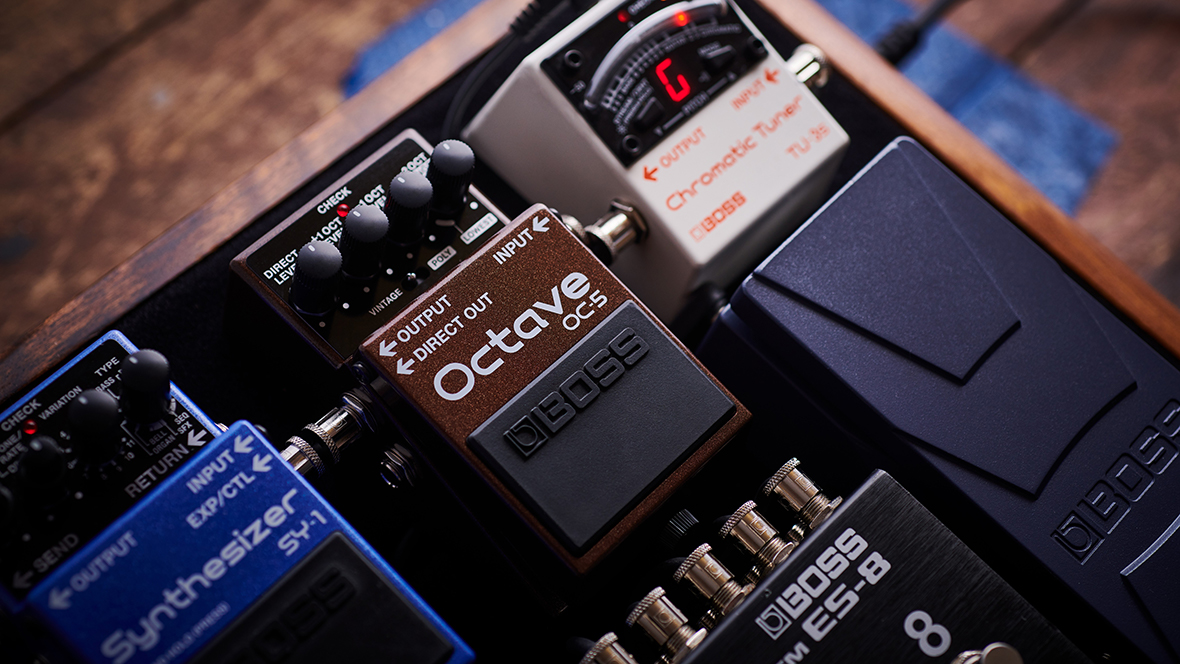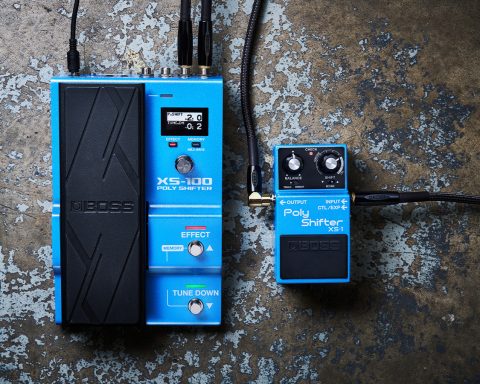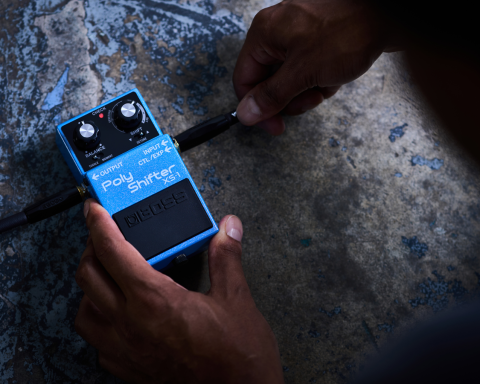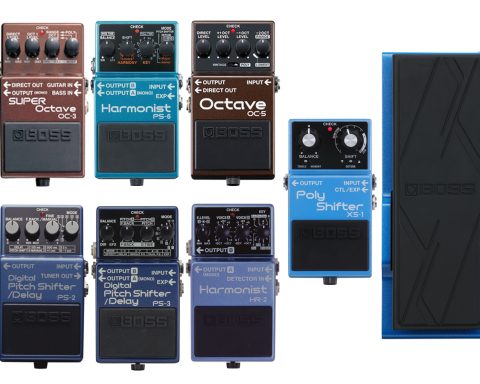The octave pedal might not be the most obvious effect to add to a pedalboard. Overdrives, delays, and modulation pedals tend to be more common essentials, and there are fewer examples of octave pedals defining a guitarist’s tone. Despite this, the octave pedal can be a secret weapon. Combined with other effects to enhance and expand their range, octave pedals can carve a path for guitarists to veer into synth tones and big bass riffs. Find out how to utilize this expansive effect.
Combining Pedals
Octave is an effect best served with other pedals. It comes to life when enhancing a drive or turning a fuzz into a bass synth. There are endless applications for such a seemingly simple tool. With that in mind, here are some perfect pedal partners for octave effects.
PEDAL COMBINATIONS
Overdrive
Pairing an octave pedal with overdrive is a great way to get more out of a drive pedal, pushing and fattening the tone. This combination is excellent for big riffs or to fill out some of the missing frequency range during a solo.
In this instance, an octave pedal can subtly thicken a drive sound. Set the clean blend of the octave pedal fully clockwise. This setting ensures the drive pedal receives the same clean signal as when the octave pedal gets bypassed. Then blend in the -1 octave to taste, generally around 10 o’clock, with the -2 octave at around 9 o’clock. This robust drive tone will add warmth and depth and can push heavier music sections to another level.
Recommended Pairings
- BOSS OC-5 and SD-1W
- BOSS OC-5 and BD-2W
Fuzz
Octave and fuzz are like peanut butter and jelly. They blend so perfectly that players have paired them for decades. Still, using them as two separate effects dramatically increases a guitarist’s ability to shape their octave fuzz tone.
A classic example of this pairing is utilizing the +1 polyphonic octave on the OC-5. Fully boost the +1 octave while zeroing all the other octaves. Blend clean signal slightly. Paired with a fuzz pedal—something with a gated, spluttery voice—this combo creates an abrasive bee-in-a-box tone reminiscent of Hendrix’ “Purple Haze.”
Recommended Pairing
- BOSS OC-5 and FZ-1W
"Octave and fuzz are like peanut butter and jelly. They blend so perfectly that players have paired them for decades."
Reverb
This combo is a less obvious pairing than others on this list. Yet octave and reverb work effectively to create convincing organ-like tones, great for guitarists looking to do something different. To achieve this tone, select the polyphonic setting on the octave pedal and push the +1 and -1 octaves to almost full rotation. Next, lower the clean signal in the mix, and use the -1 octave sparingly.
Used alone, this setting will give chords a psychedelic organ-like voice. However, it will sound dry and muted, especially in the upper octave. Engaging the reverb pedal will allow this abrasive sound to settle down, taking the edge off the prominent +1 octave frequencies. This setting will also emulate the church-like echo that goes hand in hand with organ-style tones.
Recommended Pairings
- BOSS OC-5 and RV-6
- BOSS OC-5 and RV-500
Tremolo
Pairing it with tremolo is a great way to get some unique synth-like tones from an octave pedal. While both effects are classic in origin, they can both get pushed to create unusual synth-like sounds.
For this sort of effect, set the -1 and -2 octaves at near full rotation and completely zero out the clean signal. Then add the tremolo with the rate set relatively high and the depth set fully clockwise. Used to play simple bass lines, this will turn a guitar into a choppy, retro bass synth, perfect for funky dance basslines.
Recommended Pairing
- BOSS OC-5 and TR-2
"Pairing it with tremolo is a great way to get some unique synth-like tones from an octave pedal."
Bass Preamps
The least obvious but one of the most valuable pairings is to combine an octave pedal with a bass preamp, such as the BB-1X. This combination is most effective via the direct out of the OC-5. The direct out lets the player send a wet octave signal to a separate output, leaving the signal to a guitar amplifier intact.
One can control and adjust the voicing of the affected output by setting the pedal to produce only a -1 octave. Then run the direct out of the octave pedal into a preamp. Doing this will emulate the tone of a bass amplifier. Most bass preamps, the BB-1X included, have a balanced out that allows players to send that signal straight to the front of house. The feature gives the player a simulated bass amp and bass player at the cost of only two stompbox spaces on a pedalboard.
Recommended Pairing
- BOSS OC-5 and BB-1X
Setups
Placement
As with all pitch effects, position octave pedals as close to the start of a pedal chain as possible. Only compressors and some fuzz pedals should come before an octave pedal. The reason for this is clarity. Octave pedals must receive the most pristine signal possible from a guitar to pitch up or down.
This positioning is even more critical for analog octave pedals as they are monophonic. If the signal received by a monophonic octave pedal is harmonically enhanced or modulated, the pedal may struggle to pitch correctly and glitch between several notes instead.
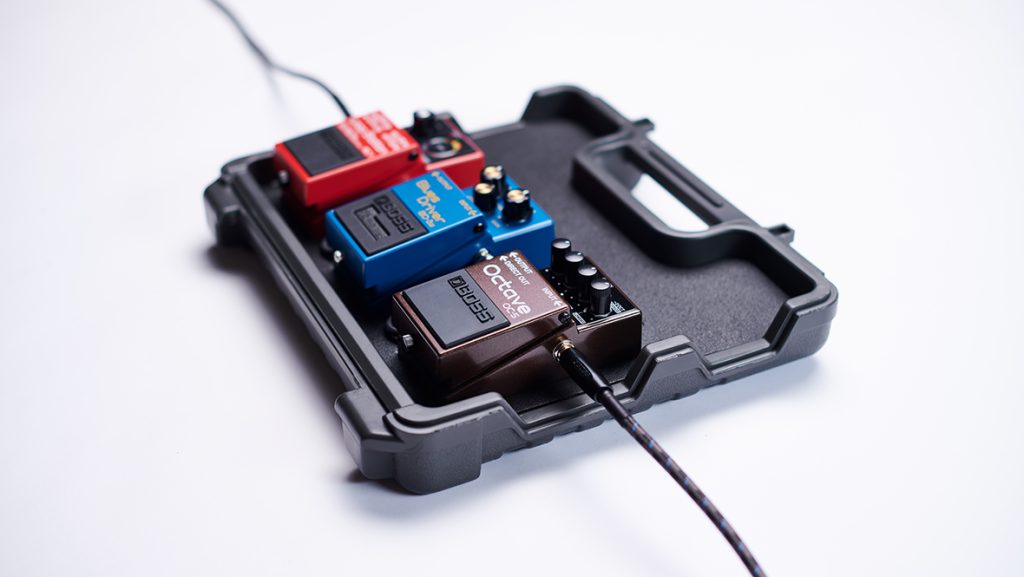
"As with all pitch effects, position octave pedals as close to the start of a pedal chain as possible."
Wet/Dry Mix
A second prevalent method of using an octave pedal is as part of a wet/dry mix. This is a great way to get the most from an octave pedal. The approach fills out a tone without muddying a signal or limiting other possible effects.
This method works with any octave pedal using a line selector. The OC-5 provides a separate direct out. The direct out allows players to send an affected signal to an independent source while sending a clean signal to an amplifier. This feature is ideal for players using an octave pedal as a bass accompaniment, allowing the bass signal to remain intact. At the same time, the clean signal can then get paired with delays and reverbs that would otherwise cloud the bass signal.
"An octave pedal can be one of the most expressive and malleable tools in a guitarist’s arsenal."
Expressive and Malleable
Octave pedals are creative tools that excel when used to enhance other effects. Use them to create everything from bass synths to screeching solos. They might not be as essential an effect type as overdrive or delay, but they can be some of the most expressive and malleable pedals in a guitarist’s arsenal.

